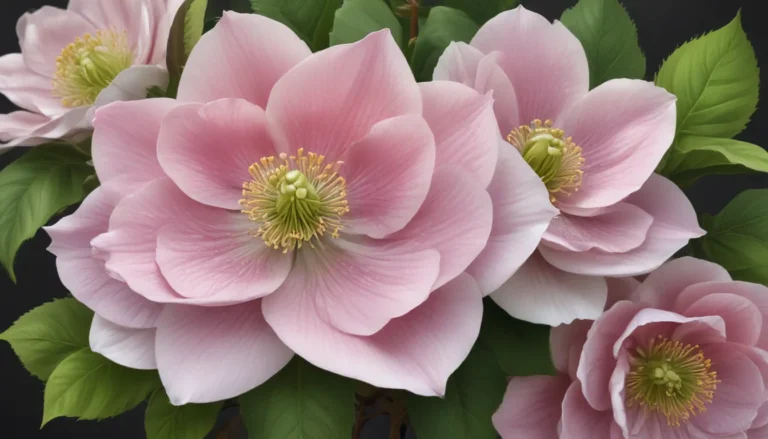The pictures we use in our articles might not show exactly what the words say. We choose these pictures to make you interested in reading more. The pictures work together with the words but don’t take their place. The words still tell you the important facts.
Are you ready to discover the enchanting world of Cranesbill? Also known as Geranium, this stunning flowering plant is more than just a pretty face. With its rich history, cultural significance, and medicinal properties, Cranesbill is a true botanical marvel that has captured the hearts of plant enthusiasts and gardeners worldwide. Join us as we explore 15 astounding facts about this remarkable plant and uncover the secrets of its beauty and resilience.
Unlocking the World of Cranesbill
Let's start our journey by delving into the captivating world of Cranesbill and uncovering some key takeaways that highlight the versatility and allure of this extraordinary plant.
- Cranesbill, also known as geranium, is a beautiful flowering plant with over 400 species.
- It has medicinal properties, attracts pollinators, and is easy to grow, making it a versatile and resilient addition to any garden.
- Some species of Cranesbill are edible and it has cultural significance worldwide, inspiring various cultivars that add beauty and elegance to gardens.
Cranesbill: A Blooming Beauty
Cranesbill, with its delicate petals and vibrant colors, is a sight to behold in any garden or floral arrangement. Let's explore more about this beautiful flowering plant.
- Cranesbill, also known as geranium, is a beautiful flowering plant that belongs to the Geraniaceae family.
- With over 400 different species of Cranesbill, each varying in size, color, and growth habit, it adds diversity and allure to gardens worldwide.
Medicinal Marvels of Cranesbill
Beyond its beauty, Cranesbill also offers an array of medicinal properties that have been valued for centuries in traditional medicine. Let's uncover the healing secrets of this remarkable plant.
- Cranesbill contains compounds with antimicrobial and anti-inflammatory effects, making it valuable for treating wounds, skin conditions, and gastrointestinal issues.
The Origins of the Name
Have you ever wondered how Cranesbill got its unique name? Let's uncover the origin of the name and its symbolic significance.
- The name "Cranesbill" is derived from the shape of its seed pods, which resemble the beak of a crane, adding to the plant's charm and distinctiveness.
Thriving in Diverse Habitats
From meadows to woodlands, Cranesbill is a plant that can adapt to various habitats, thriving in different climates and soil conditions. Let's explore the versatility of this resilient plant.
- Cranesbill is found in a wide range of habitats across the globe, showcasing its adaptability and resilience to different environmental conditions.
Supporting Biodiversity
Cranesbill, with its colorful blooms, plays a crucial role in supporting pollinators such as bees and butterflies. Let's discover how this plant contributes to biodiversity and ecosystem health.
- By attracting pollinators, Cranesbill helps support pollination and maintain biodiversity, making it an essential part of the ecosystem.
Edible Delights: Some Cranesbill Species are Edible
Did you know that certain species of Cranesbill are edible? Let's explore the culinary possibilities of this versatile plant.
- The leaves and flowers of some Cranesbill species can be consumed raw in salads or cooked as a nutritious addition to various dishes, offering a unique dining experience.
Easy to Grow and Maintain
Whether you're a seasoned gardener or a novice, Cranesbill is a perfect choice for adding beauty to your garden. Let's explore why this plant is a favorite among garden enthusiasts.
- Cranesbill is relatively low-maintenance and can thrive in both sun and shade, making it accessible for gardeners of all levels of experience.
Cultural Significance and Symbolism
Cranesbill holds cultural significance in various regions around the world, with uses ranging from traditional ceremonies to herbal medicine. Let's uncover the cultural symbolism of this beloved plant.
- Throughout history, Cranesbill has been used in traditional ceremonies, herbal medicine, and folklore, symbolizing different virtues and beliefs in various cultures.
Ornamental Elegance
With its vibrant flowers and attractive foliage, Cranesbill adds a touch of beauty and elegance to any garden or landscape. Let's explore the ornamental value of this stunning plant.
- Cranesbill's versatility and aesthetic appeal make it a popular choice among gardeners and landscapers, adding a touch of elegance to outdoor spaces.
Propagation Made Easy
If you're looking to expand your Cranesbill collection, propagation is a simple and rewarding process. Let's explore how you can grow more of these beautiful plants and share their beauty with others.
- Cranesbill can be easily propagated through division or by collecting and sowing its seeds, allowing you to share the beauty of this plant with friends and family.
Deer-Resistant Delight
One of the advantages of Cranesbill is its deer-resistant properties, making it a great choice for gardens in areas frequented by these nibbling creatures.
- Cranesbill's bitter-tasting leaves and flowers deter deer from feeding on your plants, ensuring they remain beautiful and undisturbed in your garden.
Long-Blooming Beauty
When you plant Cranesbill in your garden, you can enjoy a prolonged blooming period that adds color and vibrancy to your outdoor space. Let's uncover the secrets of its long-lasting blooms.
- Depending on the species, Cranesbill can produce flowers from spring to fall, providing a continuous display of colors throughout the seasons.
Sustainable Dye-Producing Plant
Certain species of Cranesbill can be used to create natural dyes that range from soft pinks to vibrant purples. Let's explore the eco-friendly and sustainable dye-making potential of this remarkable plant.
- The petals of specific Cranesbill species yield beautiful hues that can be used in natural dye-making, offering a sustainable alternative to synthetic dyes.
Cultivar Inspiring Beauty
The beauty and versatility of Cranesbill have inspired horticulturists to develop numerous cultivars with unique characteristics. Let's explore the diverse world of Cranesbill cultivars.
- Various cultivars of Cranesbill exhibit different flower colors, leaf patterns, and growth habits, providing gardeners with a wide array of options to choose from.
Conclusion: Embrace the Beauty of Cranesbill
In conclusion, Cranesbill is a fascinating plant with a rich history and numerous benefits. From its beautiful flowers to its medicinal properties, Cranesbill offers something for everyone. Whether you're a gardener looking to add color to your garden, or someone interested in natural remedies, Cranesbill is a remarkable plant worth incorporating into your life. Explore the wonders of Cranesbill and witness its beauty and resilience in action.
FAQs: Your Cranesbill Queries Answered
As you embark on your journey with Cranesbill, here are some frequently asked questions to guide you in your exploration of this remarkable plant.
- What is Cranesbill?
-
Cranesbill is a perennial flowering plant that belongs to the Geranium genus, known for its delicate flowers and distinctive foliage.
-
Where can I find Cranesbill?
-
Cranesbill is native to many regions globally and can be found in various habitats, including meadows, woodlands, and gardens.
-
How do I grow Cranesbill?
-
Cranesbill is relatively easy to grow and prefers well-drained soil and partial shade. Planting in early spring or fall is recommended.
-
What are the medicinal uses of Cranesbill?
-
Cranesbill has been used in traditional medicine to treat various ailments like diarrhea, urinary tract infections, and gastrointestinal disorders.
-
Can I use Cranesbill in cooking?
-
While not commonly used in cooking, some people use Cranesbill leaves and flowers to add a mild floral flavor to salads or teas.
-
Is Cranesbill toxic to pets?
-
Cranesbill is generally safe for pets, but it's best to consult with a veterinarian before introducing it into your pet's environment.
-
How long does Cranesbill bloom?
-
The blooming period varies by species and growing conditions, but generally, Cranesbill blooms from spring to summer.
-
Can Cranesbill attract pollinators?
-
Yes, Cranesbill flowers attract bees and butterflies, making them an excellent choice for supporting pollinator populations.
-
How can I propagate Cranesbill?
-
Cranesbill can be propagated through division or by collecting and planting its seeds, maintaining the health and vigor of the plant.
-
Are there different varieties of Cranesbill?
- Yes, there are numerous species and cultivars of Cranesbill, each with unique characteristics, colors, and growth habits.
Trustworthy Information at Your Fingertips
Our commitment to providing engaging and reliable content is evident in each fact we share about Cranesbill. Your exploration of this remarkable plant is enriched by the diverse insights contributed by real users like you. To ensure the highest standards of accuracy and authenticity, our dedicated editors meticulously review each submission, guaranteeing that the facts we provide are not only fascinating but also credible. Trust in our commitment to quality and authenticity as you delve into the world of Cranesbill and uncover its fascinating secrets.






